Abstract
OBJECTIVE: We compare mental health utilization in prepaid and fee-for-service plans and analyze selection biases. DATA SOURCE: Primary data were collected every six months over a two-year interval for a panel of depressed patients participating in the Medical Outcomes Study, an observational study of adults in competing systems of care in three urban areas (Boston, Chicago, and Los Angeles). STUDY DESIGN: Patients visiting a participating clinician at baseline were screened for depression, followed by a telephone interview, which included the depression section of the NIMH Diagnostic Interview Schedule. Patients with current or past lifetime depressive disorder and those with depressed mood and three other lifetime symptoms were eligible for this analysis. We analyze mental health utilization based on periodic patient self-report. ANALYTIC METHODS: We use two-part models because of the presence of both nonuse and skewness of use. Standard errors are corrected nonparametrically for correlations across observations due to clustered sampling within participating physicians and repeated observations on the same individual. PRINCIPAL FINDINGS: The average number of mental health visits was 35-40 percent lower in the prepaid system, adjusted and unadjusted for observed differences in patient characteristics, including health status. Utilization differences were concentrated among patients of psychiatrists, with only minor differences among patients of general medical providers. Analyzing the effect of switches that patients make between payment systems over time, we found some evidence of adverse selection into fee-for-service plans based on baseline utilization, but not based on utilization at the end of the study. In particular, after adjusting for observed patient characteristics and health status, patients switching out of prepaid plans had higher baseline use than predicted, whereas patients switching out of fee-for-service had lower use than predicted. Switching itself appears to be related to an immediate decline in utilization and was not followed by an increase or "catch-up" effect. CONCLUSIONS: The absence of the commonly found "catch-up" effect following switching and the significant decrease in utilization during the switching period suggests an interruption in care that does not occur for patients staying within a payment system. This finding emphasizes the need for integrating new patients quickly into a system, an issue that should not be neglected in the current policy discussion.
Full text
PDF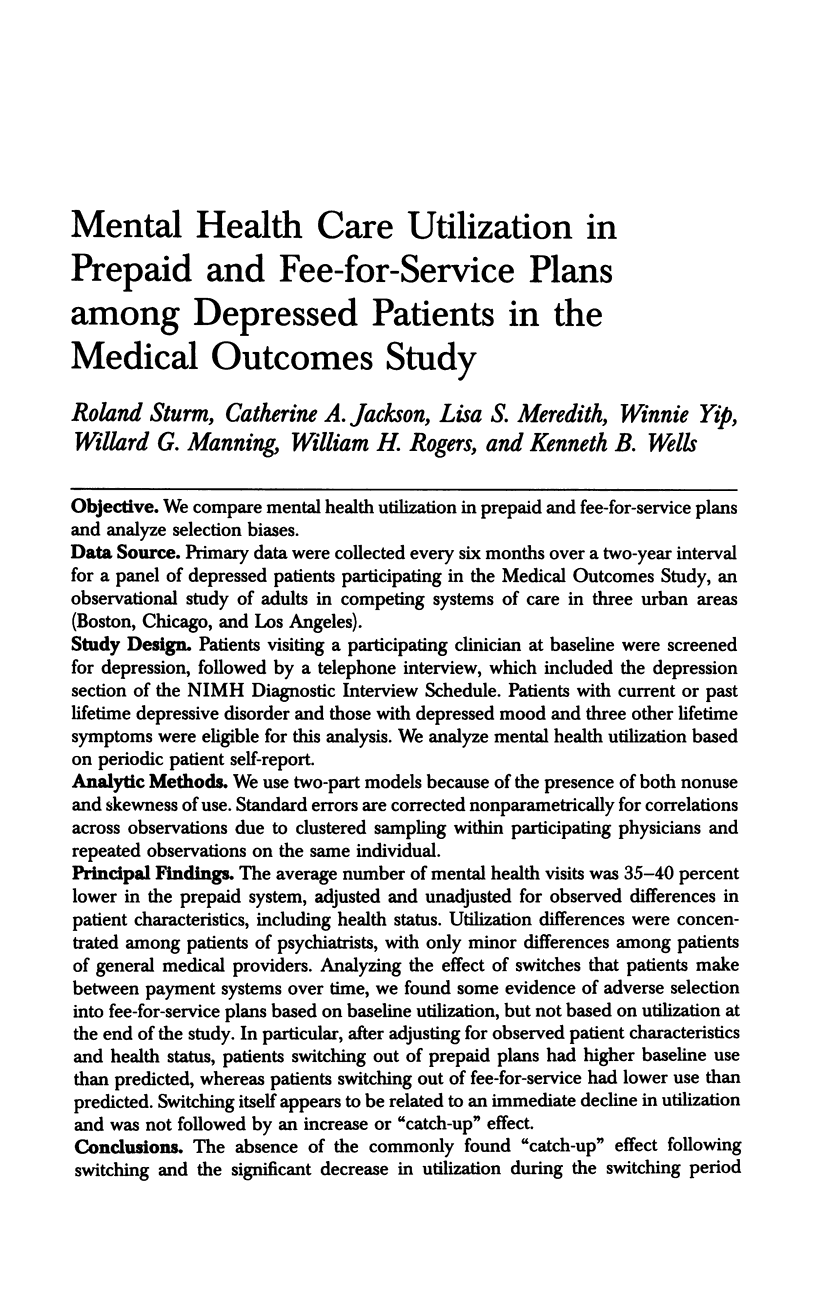
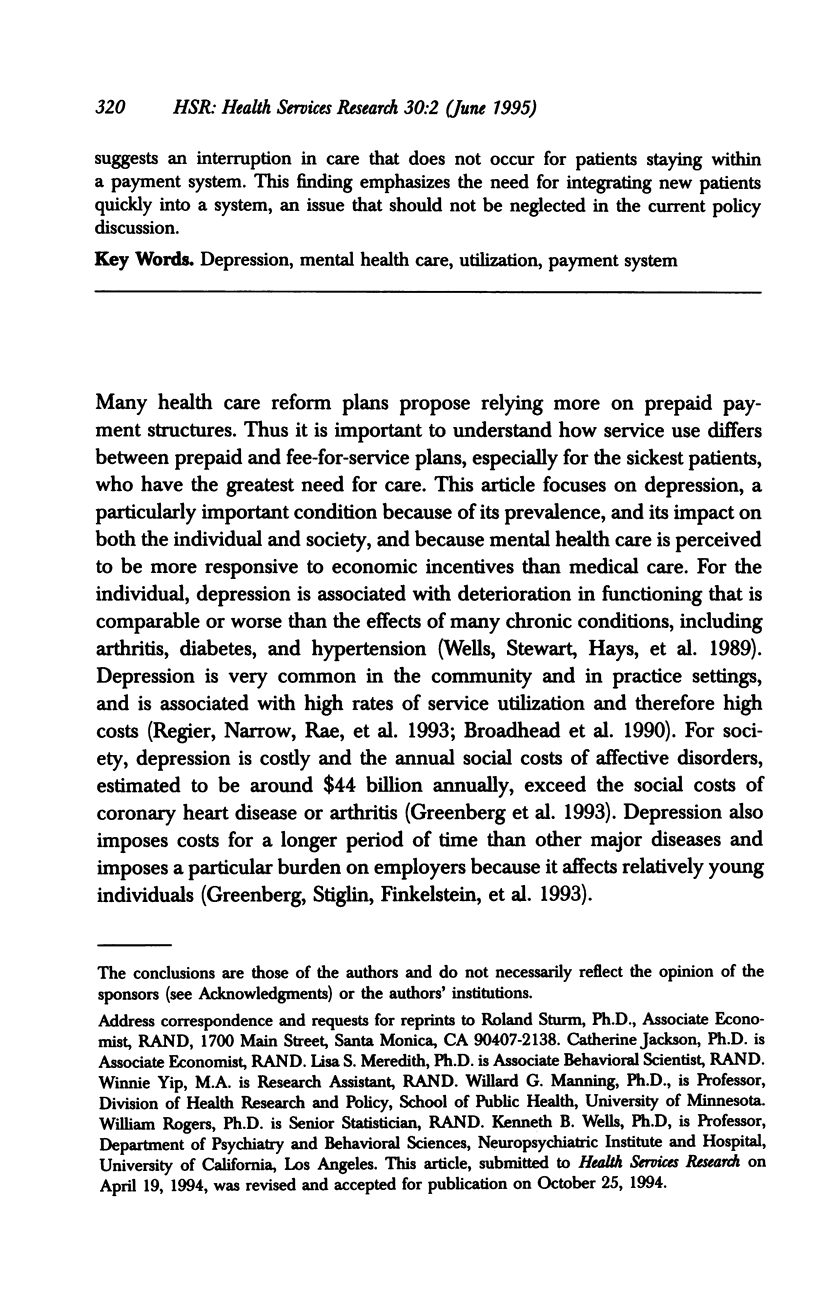
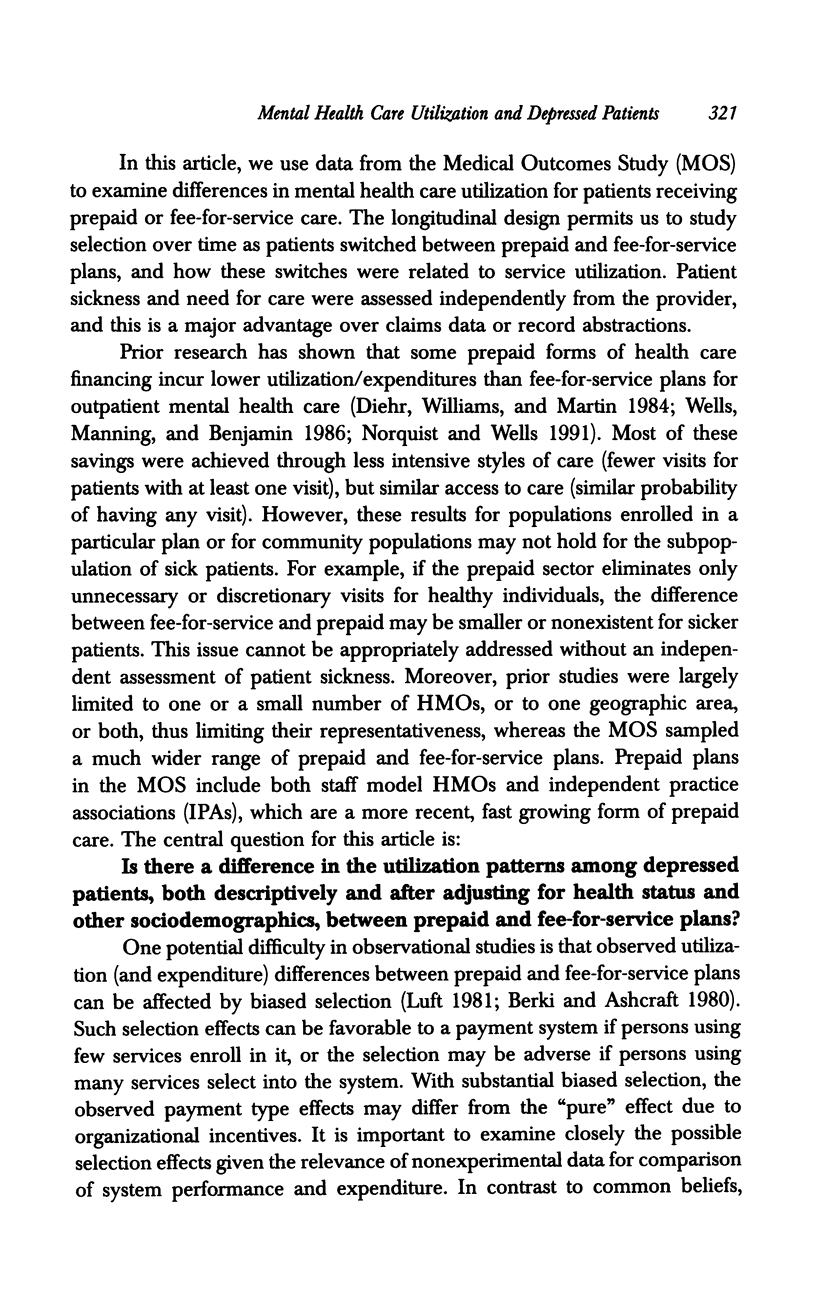
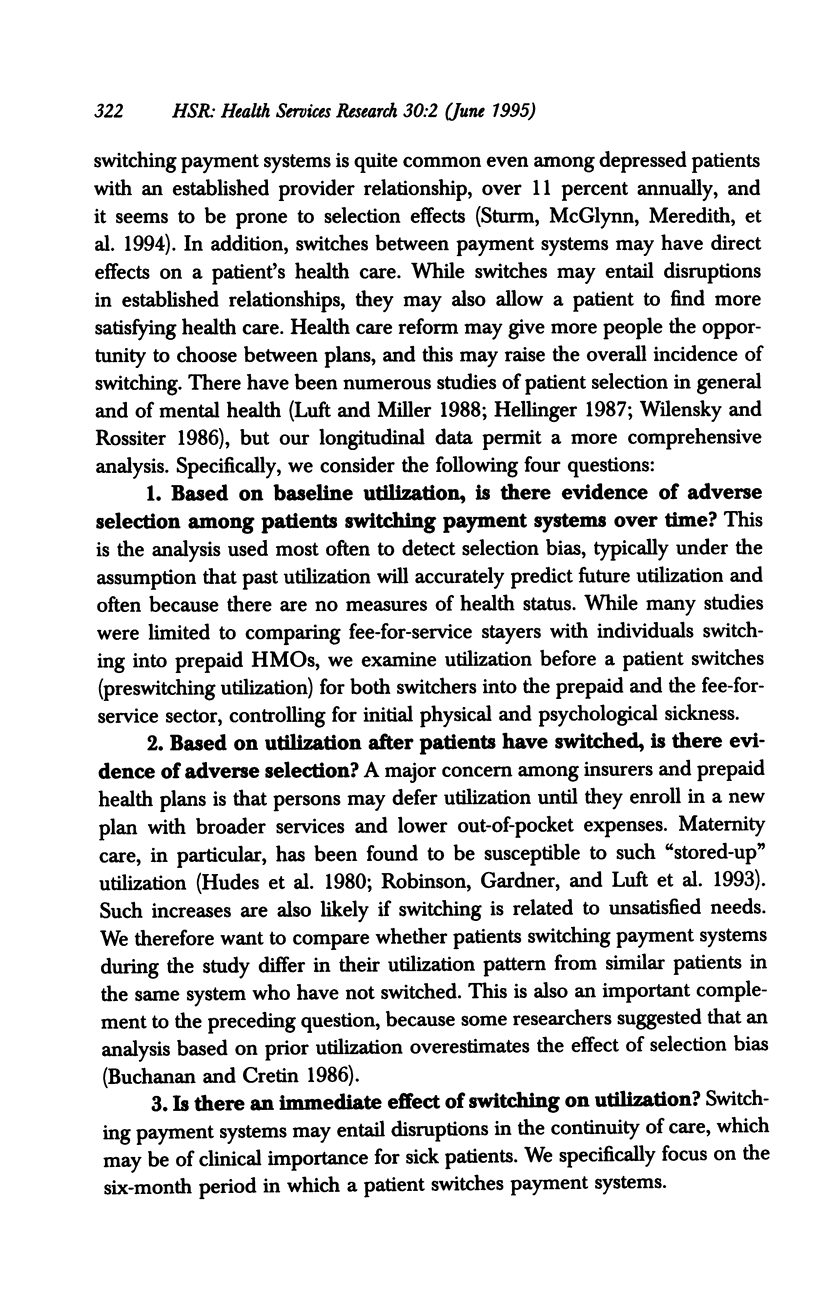
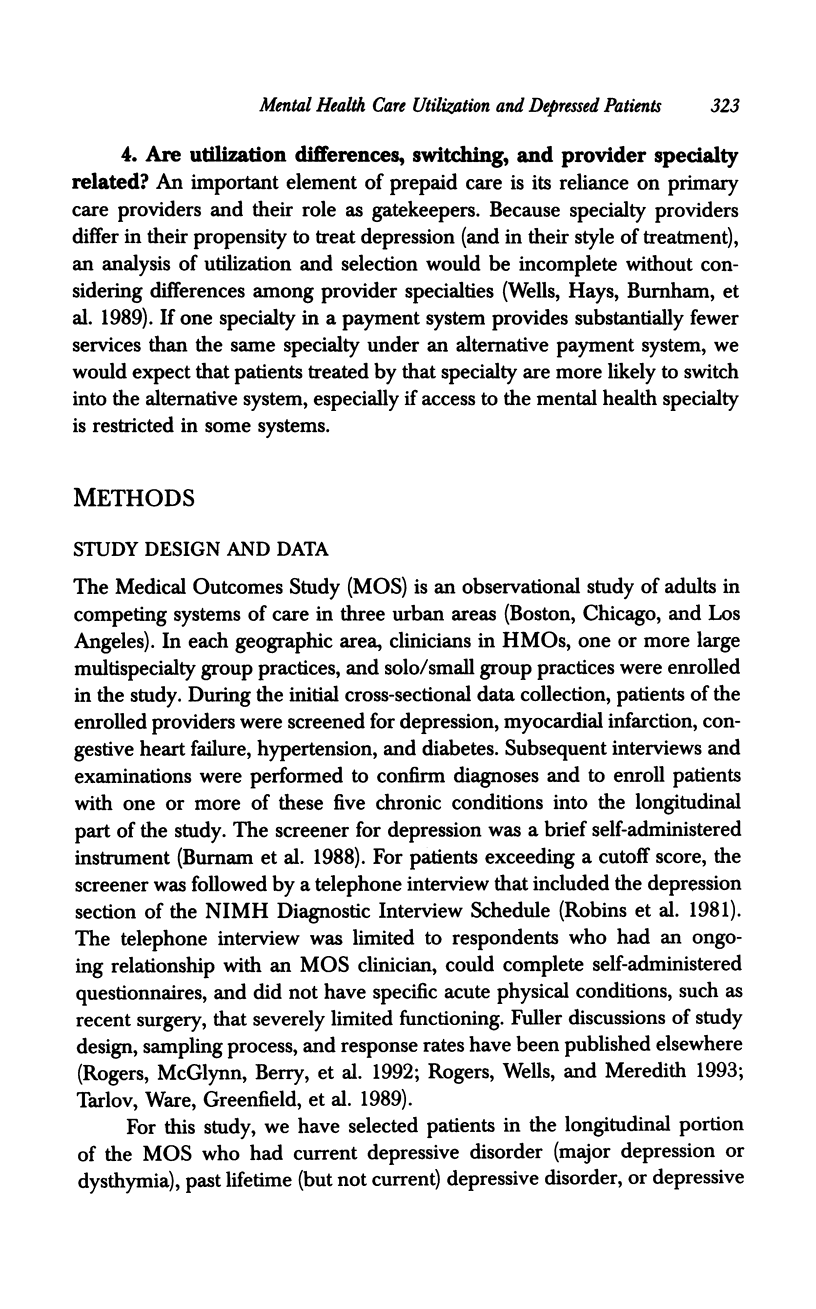
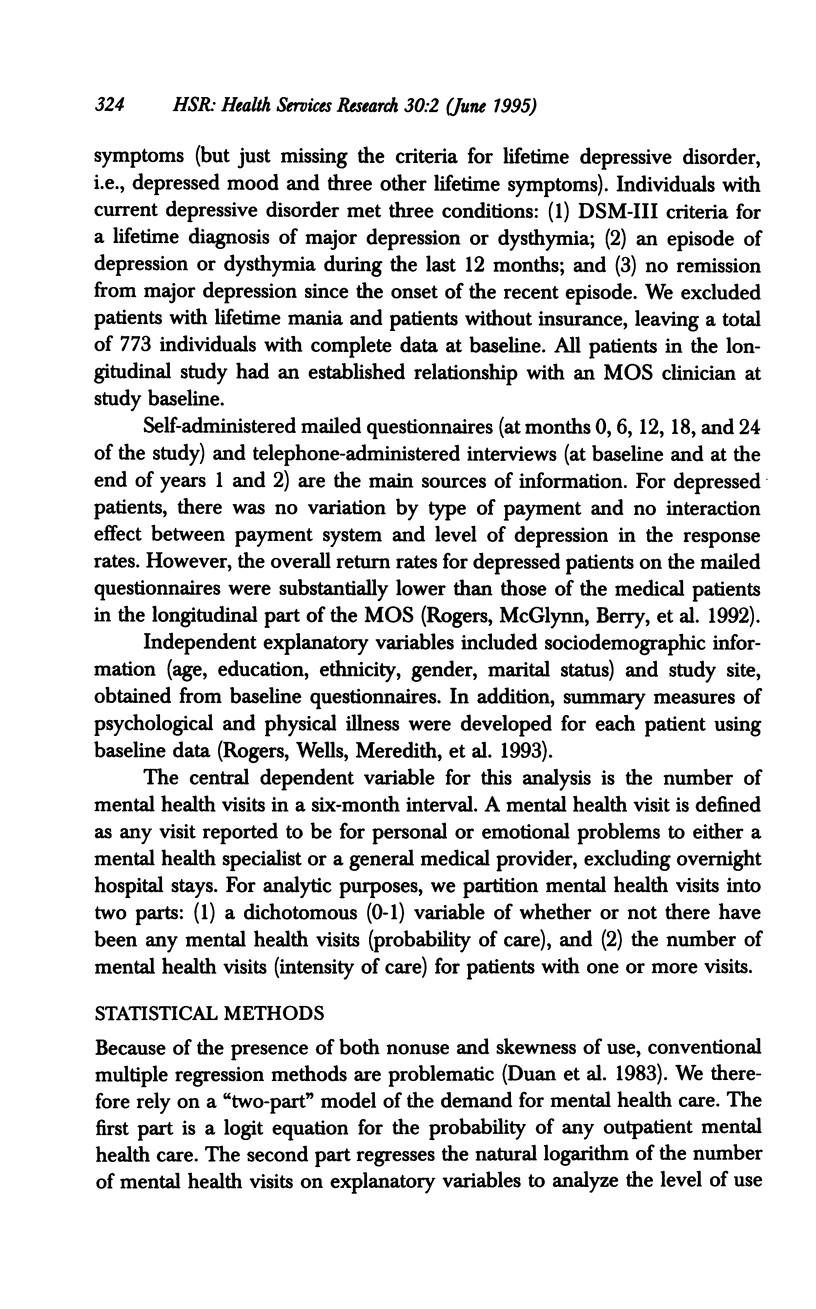
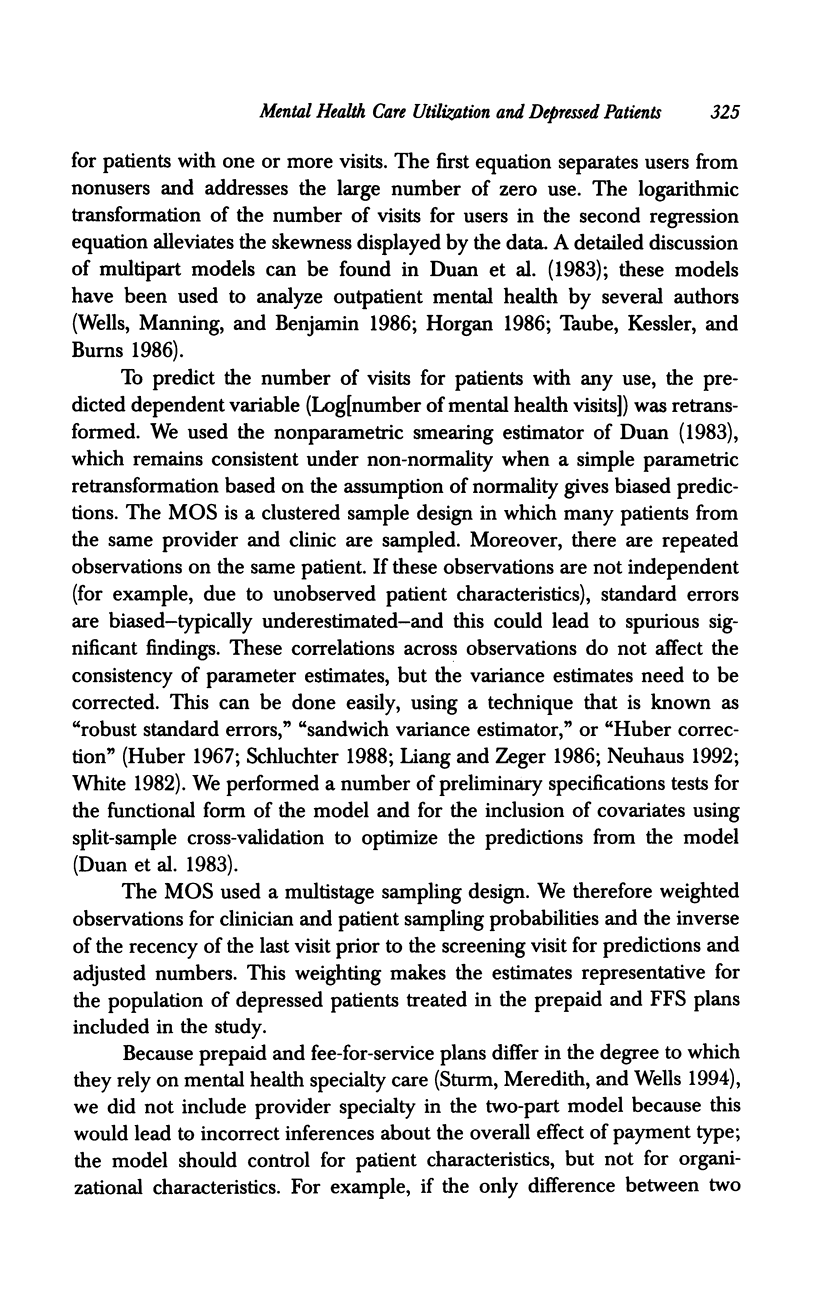
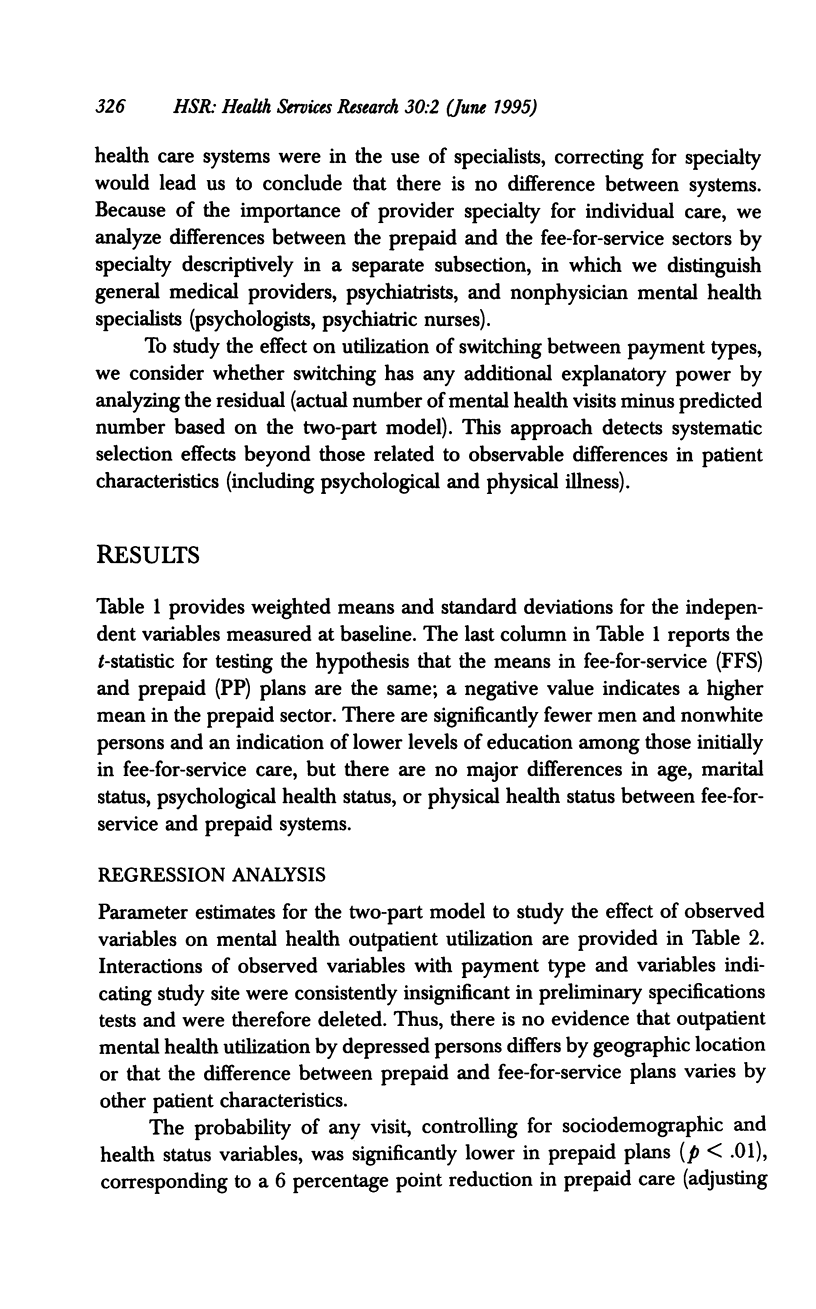
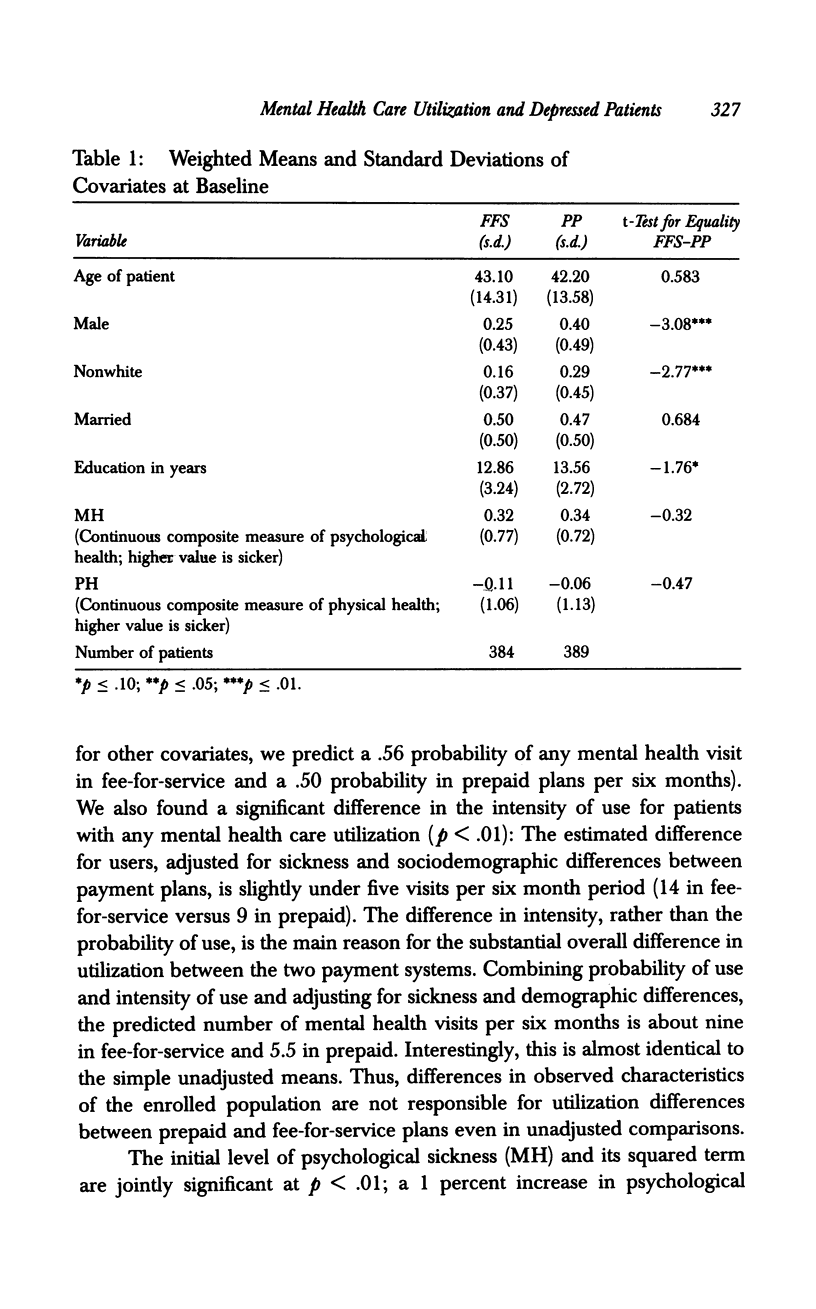
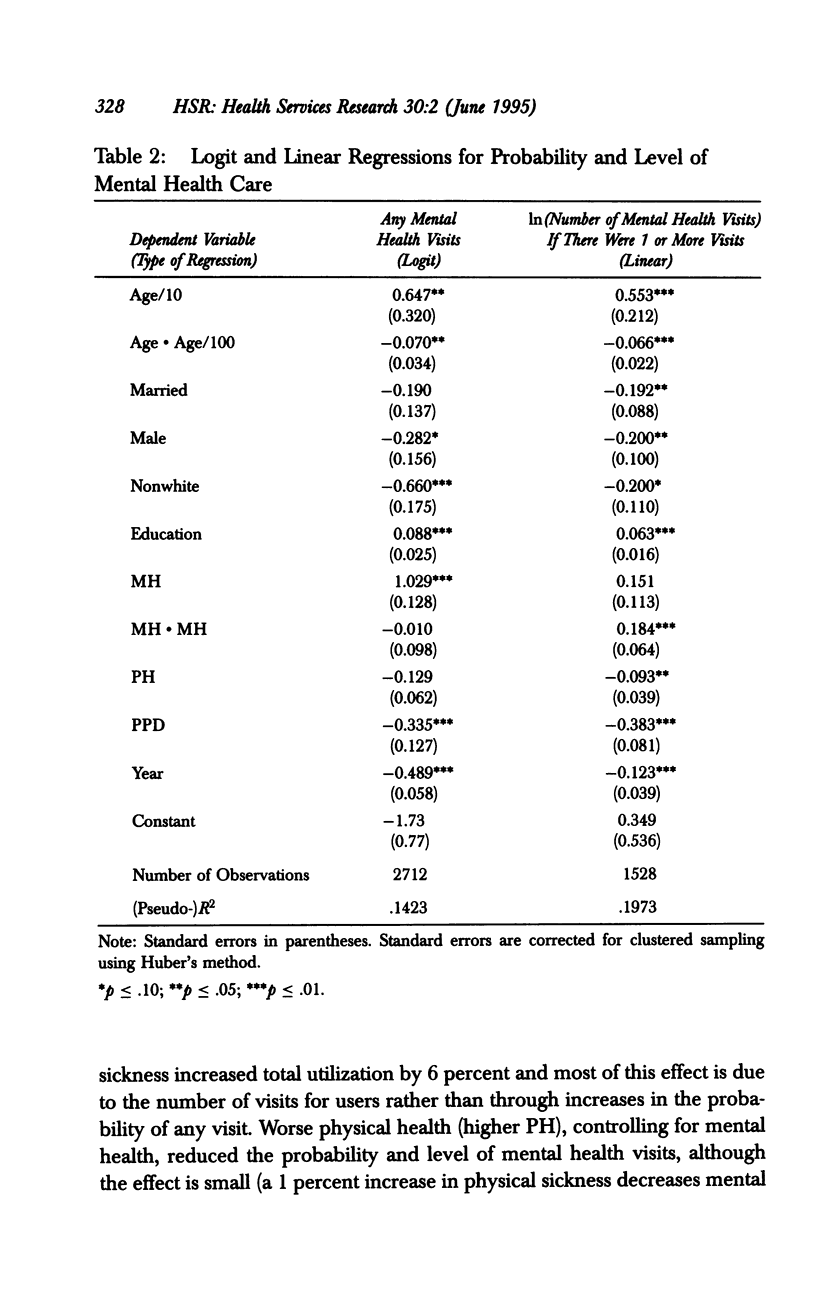
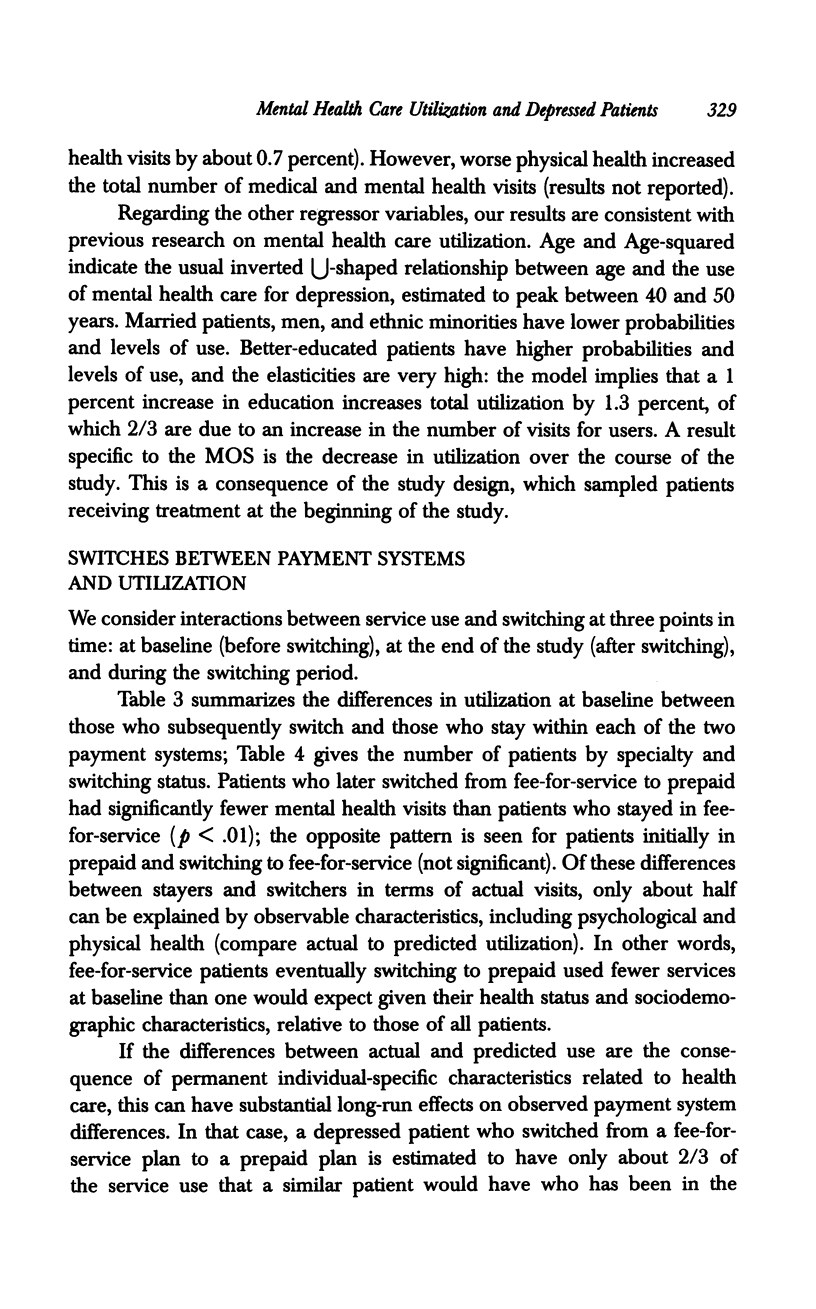
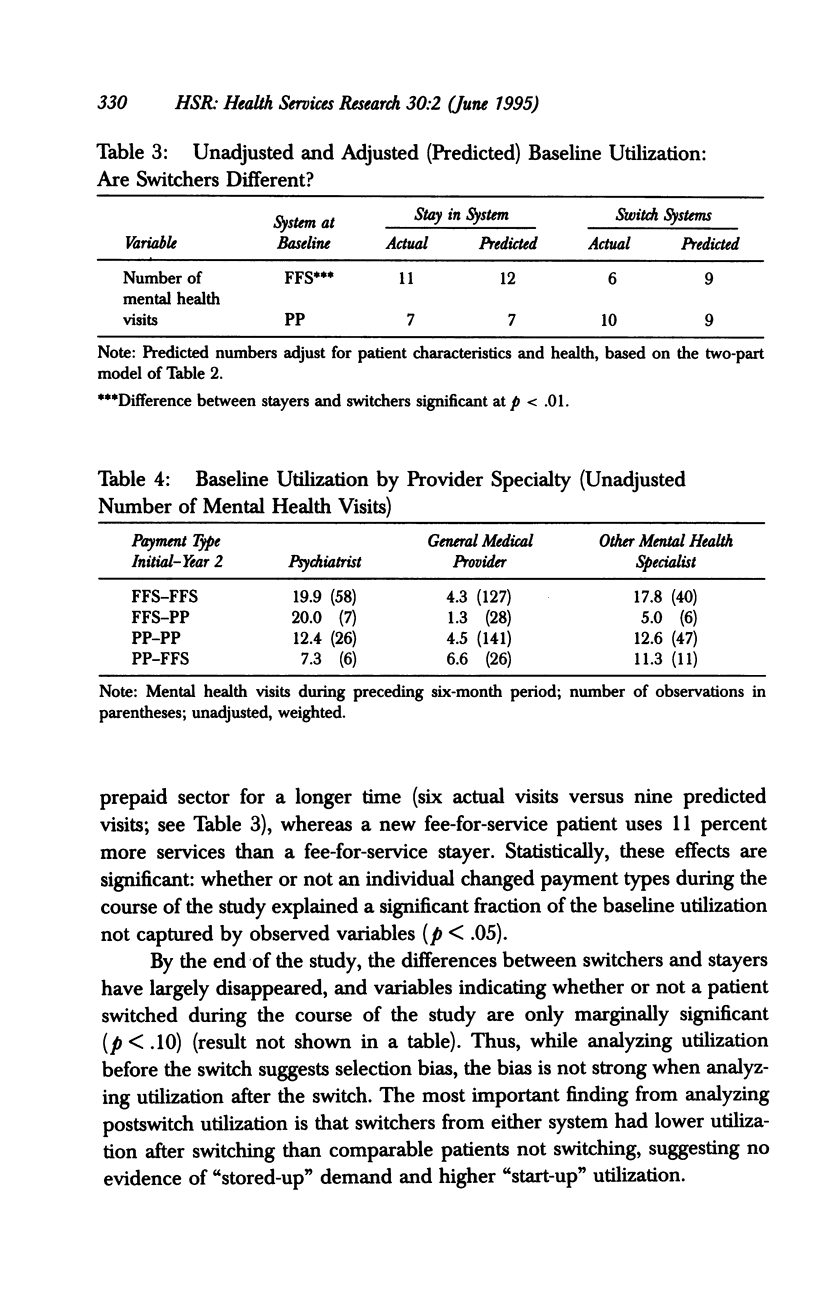
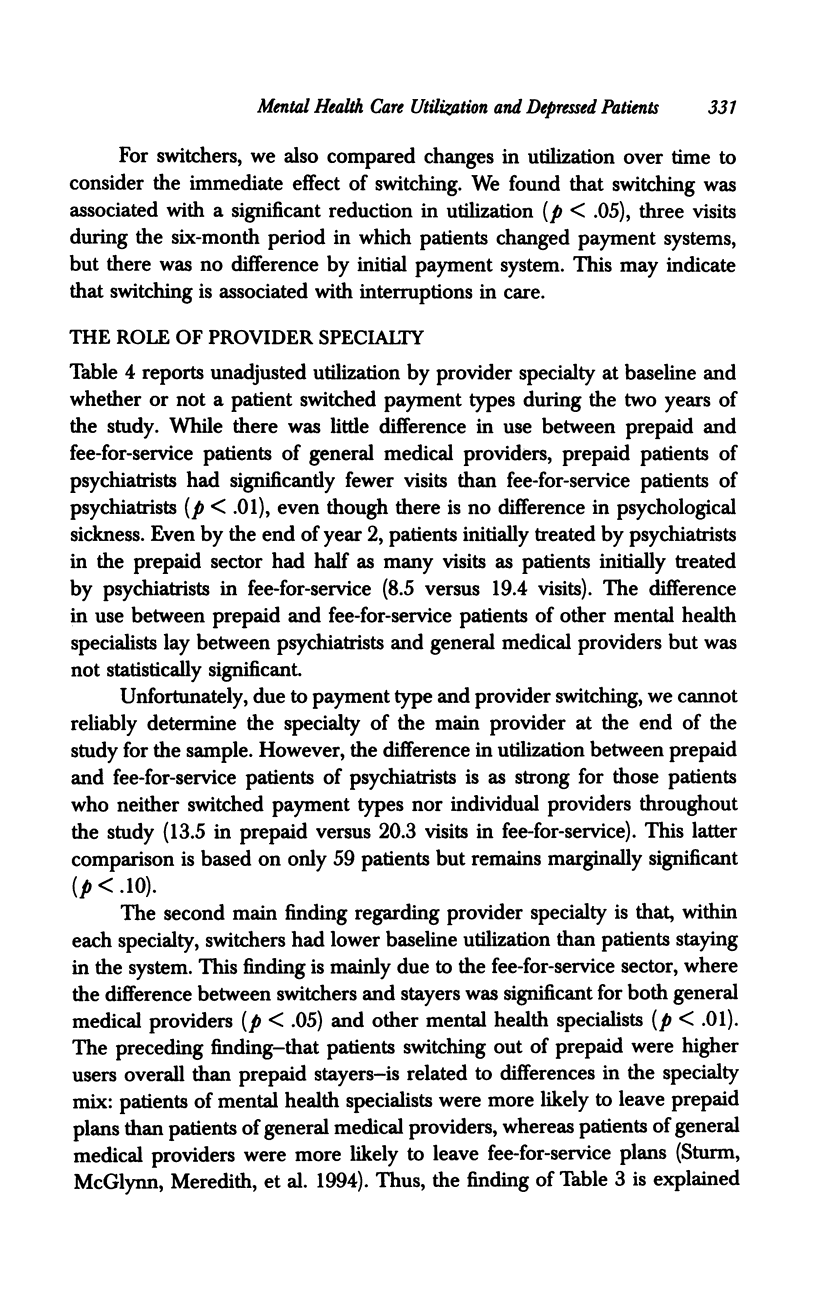
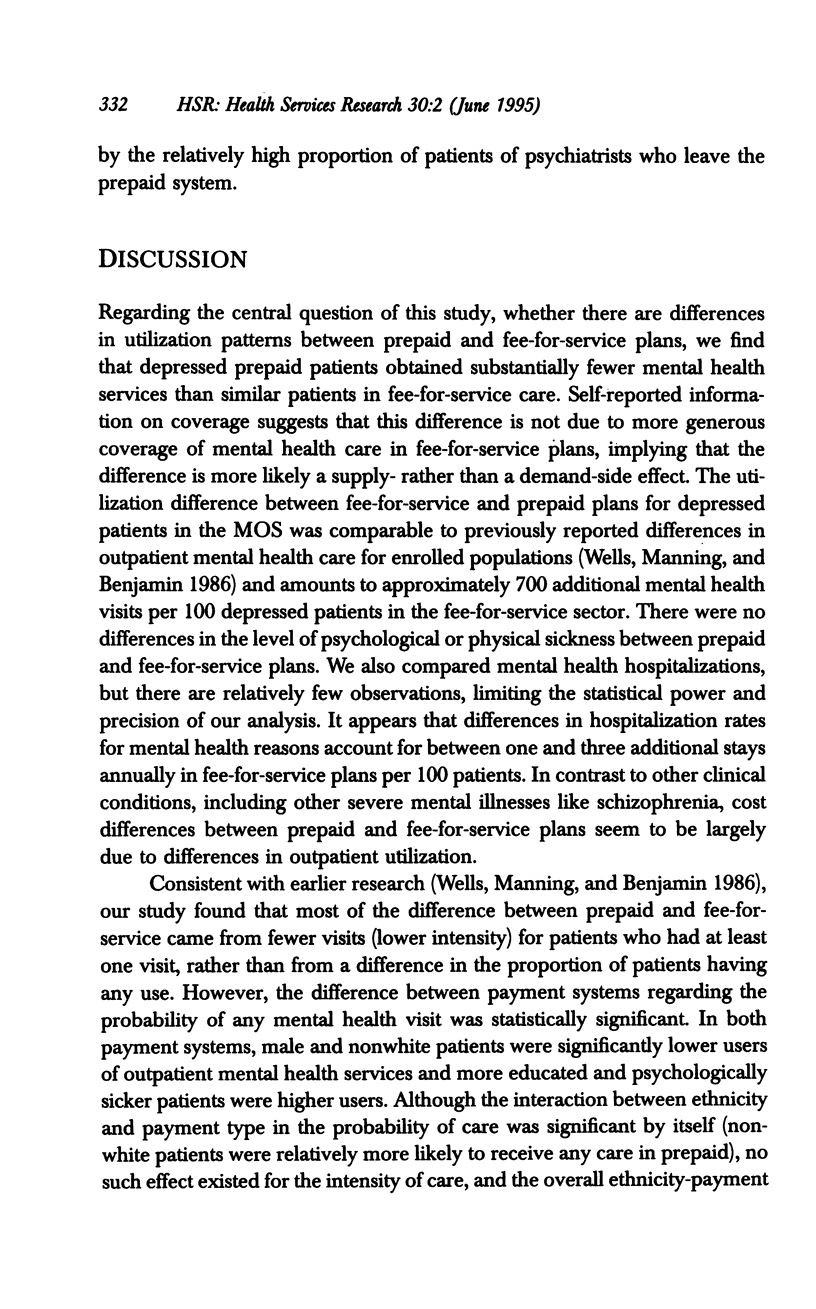
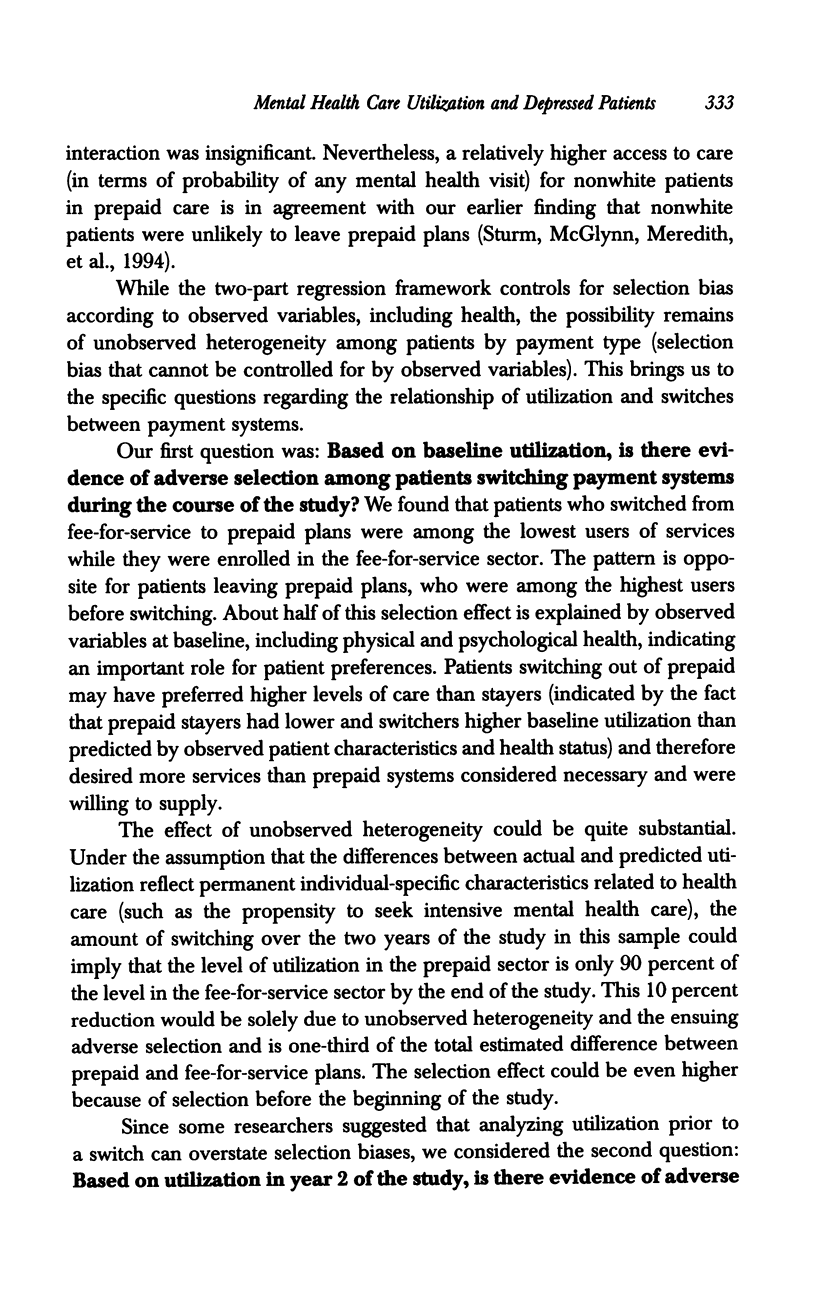
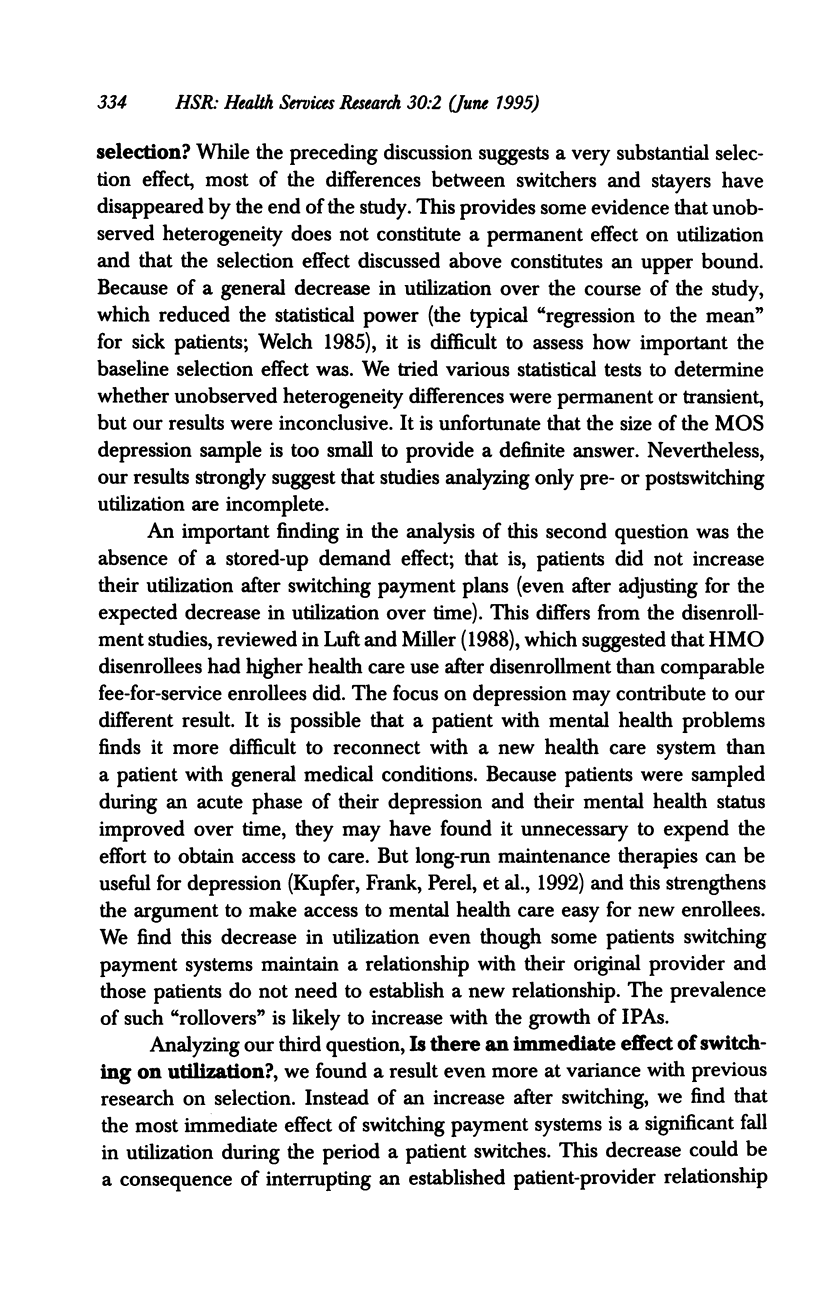
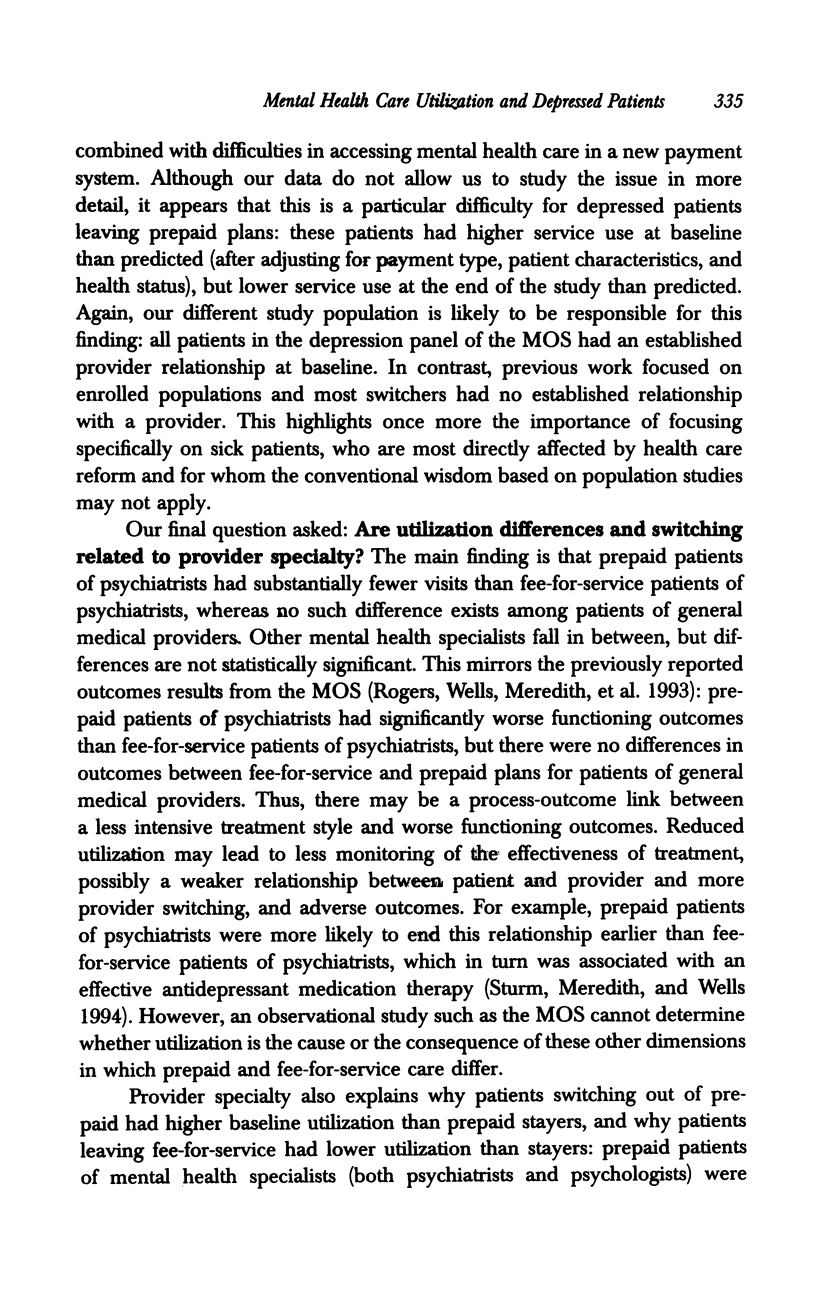
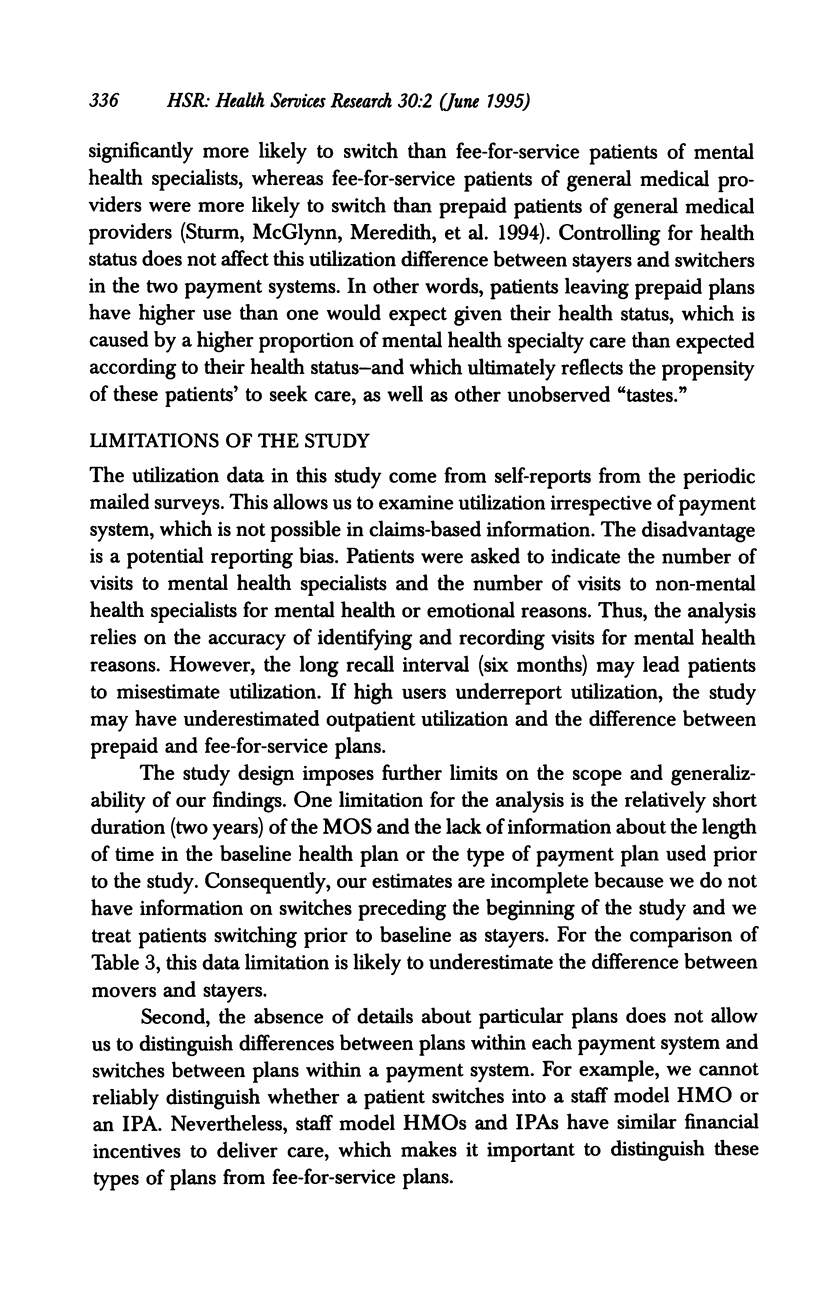
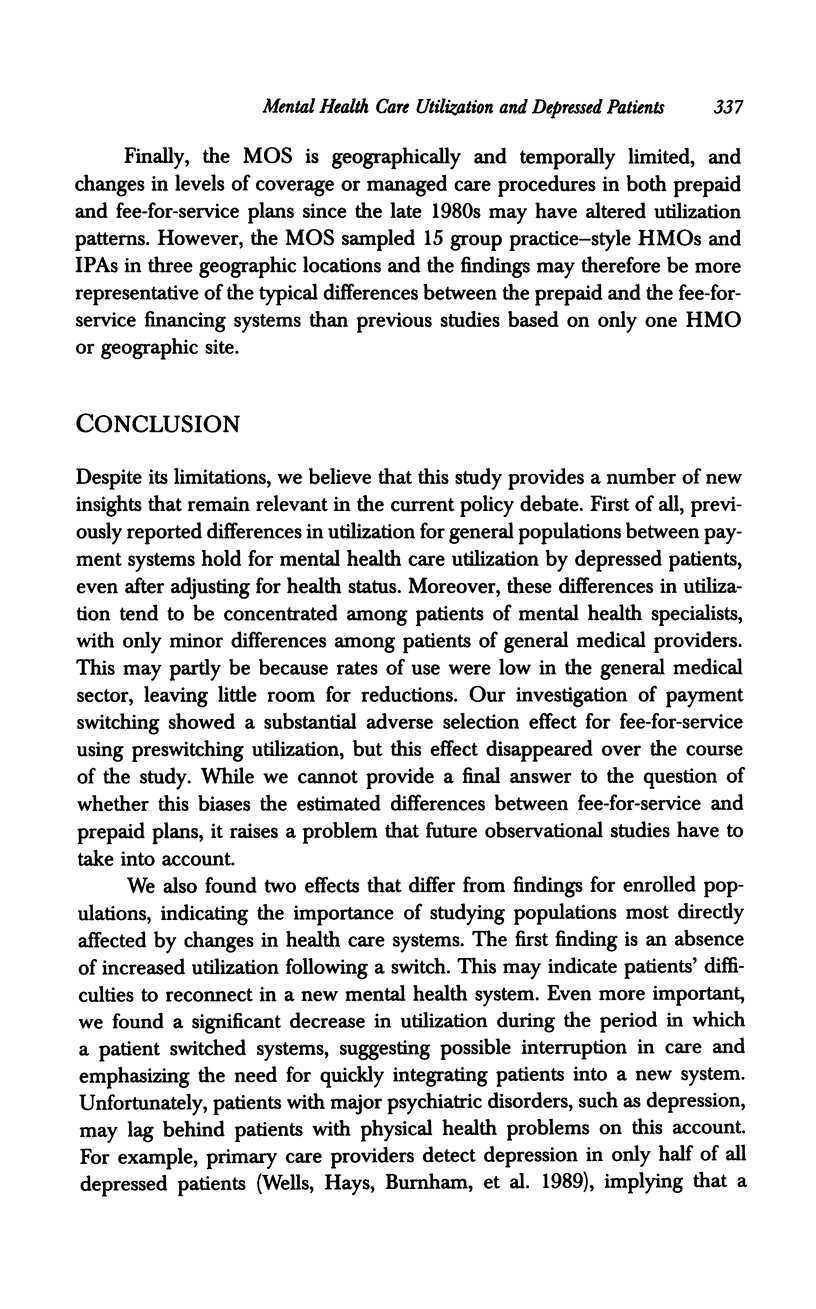
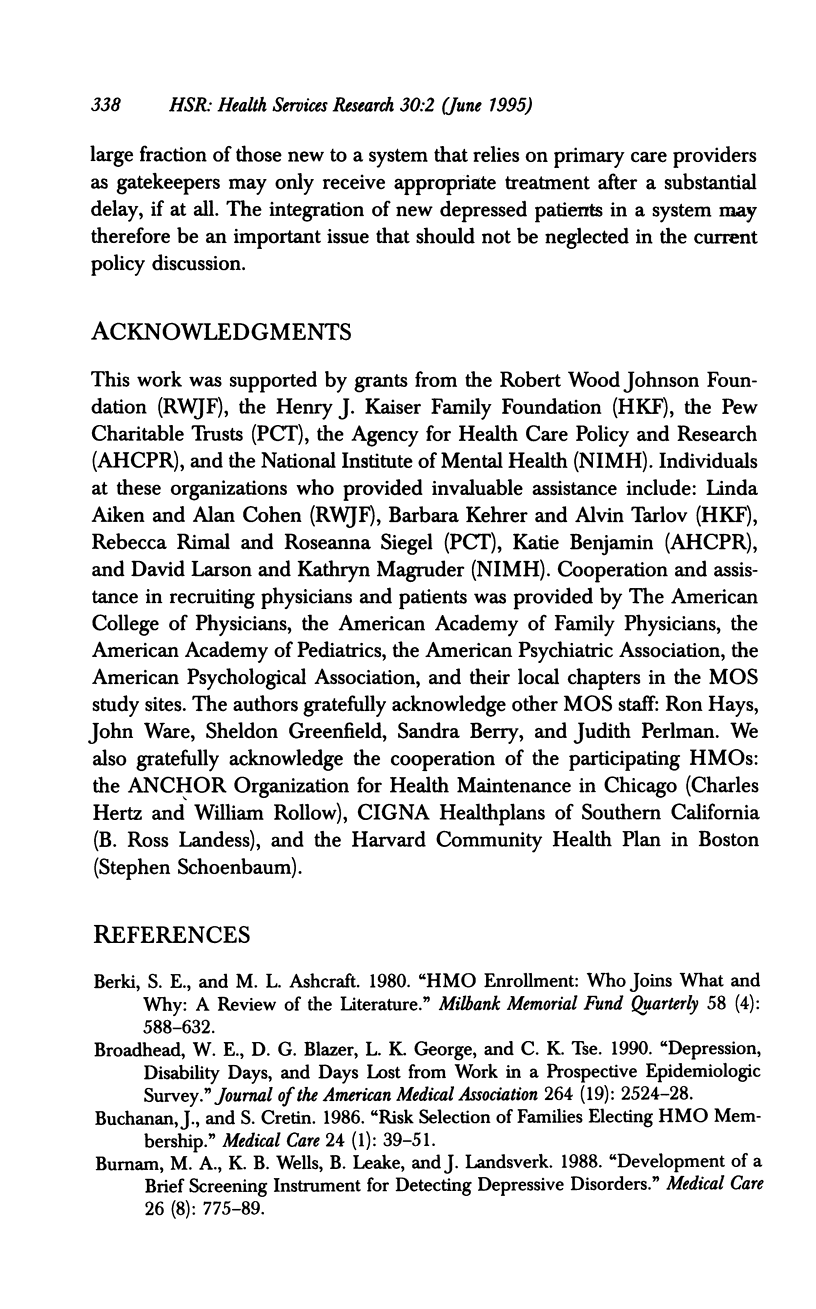
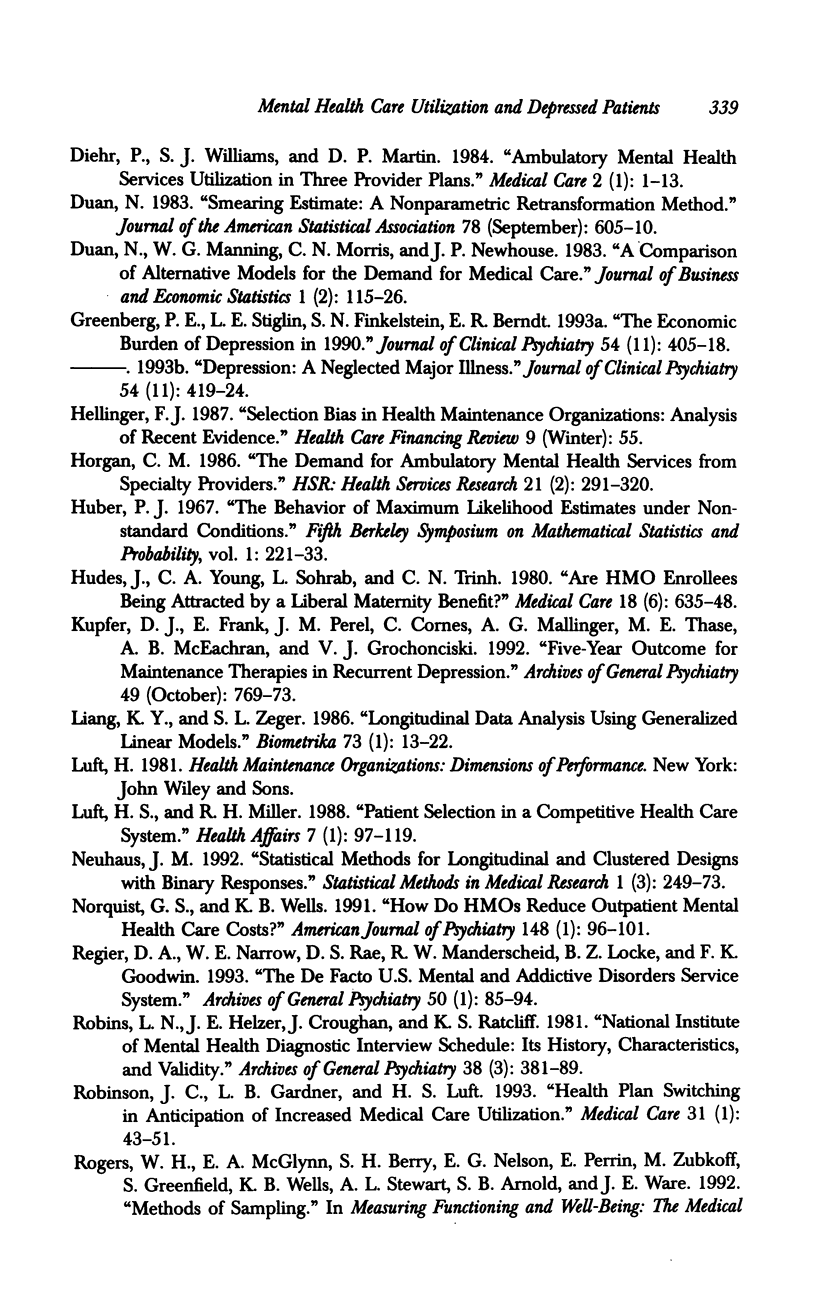
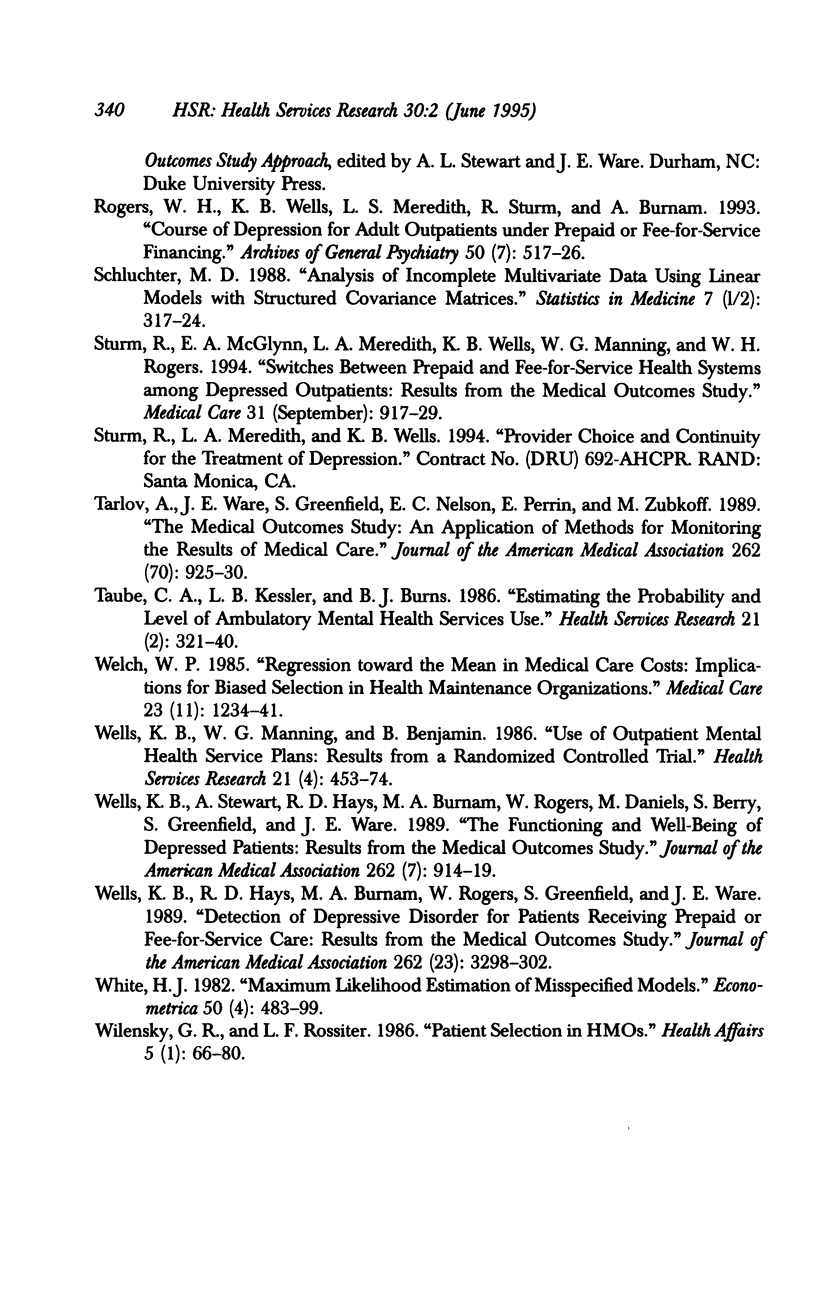
Selected References
These references are in PubMed. This may not be the complete list of references from this article.
- Berki S. E., Ashcraft M. L. HMO enrollment: who joins what and why: a review of the literature. Milbank Mem Fund Q Health Soc. 1980 Fall;58(4):588–632. [PubMed] [Google Scholar]
- Broadhead W. E., Blazer D. G., George L. K., Tse C. K. Depression, disability days, and days lost from work in a prospective epidemiologic survey. JAMA. 1990 Nov 21;264(19):2524–2528. [PubMed] [Google Scholar]
- Buchanan J. L., Cretin S. Risk selection of families electing HMO membership. Med Care. 1986 Jan;24(1):39–51. doi: 10.1097/00005650-198601000-00005. [DOI] [PubMed] [Google Scholar]
- Burnam M. A., Wells K. B., Leake B., Landsverk J. Development of a brief screening instrument for detecting depressive disorders. Med Care. 1988 Aug;26(8):775–789. doi: 10.1097/00005650-198808000-00004. [DOI] [PubMed] [Google Scholar]
- Diehr P., Williams S. J., Martin D. P., Price K. Ambulatory mental health services utilization in three provider plans. Med Care. 1984 Jan;22(1):1–13. doi: 10.1097/00005650-198401000-00001. [DOI] [PubMed] [Google Scholar]
- Greenberg P. E., Stiglin L. E., Finkelstein S. N., Berndt E. R. The economic burden of depression in 1990. J Clin Psychiatry. 1993 Nov;54(11):405–418. [PubMed] [Google Scholar]
- Hellinger F. J. Selection bias in health maintenance organizations: analysis of recent evidence. Health Care Financ Rev. 1987 Winter;9(2):55–63. [PMC free article] [PubMed] [Google Scholar]
- Horgan C. M. The demand for ambulatory mental health services from specialty providers. Health Serv Res. 1986 Jun;21(2 Pt 2):291–319. [PMC free article] [PubMed] [Google Scholar]
- Hudes J., Young C. A., Sohrab L., Trinh C. N. Are HMO enrollees being attracted by a liberal maternity benefit? Med Care. 1980 Jun;18(6):635–648. doi: 10.1097/00005650-198006000-00006. [DOI] [PubMed] [Google Scholar]
- Kupfer D. J., Frank E., Perel J. M., Cornes C., Mallinger A. G., Thase M. E., McEachran A. B., Grochocinski V. J. Five-year outcome for maintenance therapies in recurrent depression. Arch Gen Psychiatry. 1992 Oct;49(10):769–773. doi: 10.1001/archpsyc.1992.01820100013002. [DOI] [PubMed] [Google Scholar]
- Luft H. S., Miller R. H. Patient selection in a competitive health care system. Health Aff (Millwood) 1988 Summer;7(3):97–119. doi: 10.1377/hlthaff.7.3.97. [DOI] [PubMed] [Google Scholar]
- Neuhaus J. M. Statistical methods for longitudinal and clustered designs with binary responses. Stat Methods Med Res. 1992;1(3):249–273. doi: 10.1177/096228029200100303. [DOI] [PubMed] [Google Scholar]
- Norquist G. S., Wells K. B. How do HMOs reduce outpatient mental health care costs? Am J Psychiatry. 1991 Jan;148(1):96–101. doi: 10.1176/ajp.148.1.96. [DOI] [PubMed] [Google Scholar]
- Regier D. A., Narrow W. E., Rae D. S., Manderscheid R. W., Locke B. Z., Goodwin F. K. The de facto US mental and addictive disorders service system. Epidemiologic catchment area prospective 1-year prevalence rates of disorders and services. Arch Gen Psychiatry. 1993 Feb;50(2):85–94. doi: 10.1001/archpsyc.1993.01820140007001. [DOI] [PubMed] [Google Scholar]
- Robins L. N., Helzer J. E., Croughan J., Ratcliff K. S. National Institute of Mental Health Diagnostic Interview Schedule. Its history, characteristics, and validity. Arch Gen Psychiatry. 1981 Apr;38(4):381–389. doi: 10.1001/archpsyc.1981.01780290015001. [DOI] [PubMed] [Google Scholar]
- Robinson J. C., Gardner L. B., Luft H. S. Health plan switching in anticipation of increased medical care utilization. Med Care. 1993 Jan;31(1):43–51. doi: 10.1097/00005650-199301000-00003. [DOI] [PubMed] [Google Scholar]
- Rogers W. H., Wells K. B., Meredith L. S., Sturm R., Burnam M. A. Outcomes for adult outpatients with depression under prepaid or fee-for-service financing. Arch Gen Psychiatry. 1993 Jul;50(7):517–525. doi: 10.1001/archpsyc.1993.01820190019003. [DOI] [PubMed] [Google Scholar]
- Schluchter M. D. Analysis of incomplete multivariate data using linear models with structured covariance matrices. Stat Med. 1988 Jan-Feb;7(1-2):317–324. doi: 10.1002/sim.4780070132. [DOI] [PubMed] [Google Scholar]
- Sturm R., McGlynn E. A., Meredith L. S., Wells K. B., Manning W. G., Rogers W. H. Switches between prepaid and fee-for-service health systems among depressed outpatients: results from the Medical Outcomes Study. Med Care. 1994 Sep;32(9):917–929. doi: 10.1097/00005650-199409000-00003. [DOI] [PubMed] [Google Scholar]
- Tarlov A. R., Ware J. E., Jr, Greenfield S., Nelson E. C., Perrin E., Zubkoff M. The Medical Outcomes Study. An application of methods for monitoring the results of medical care. JAMA. 1989 Aug 18;262(7):925–930. doi: 10.1001/jama.262.7.925. [DOI] [PubMed] [Google Scholar]
- Taube C. A., Kessler L. G., Burns B. J. Estimating the probability and level of ambulatory mental health services use. Health Serv Res. 1986 Jun;21(2 Pt 2):321–340. [PMC free article] [PubMed] [Google Scholar]
- Welch W. P. Regression toward the mean in medical care costs. Implications for biased selection in health maintenance organizations. Med Care. 1985 Nov;23(11):1234–1241. doi: 10.1097/00005650-198511000-00002. [DOI] [PubMed] [Google Scholar]
- Wells K. B., Hays R. D., Burnam M. A., Rogers W., Greenfield S., Ware J. E., Jr Detection of depressive disorder for patients receiving prepaid or fee-for-service care. Results from the Medical Outcomes Study. JAMA. 1989 Dec 15;262(23):3298–3302. [PubMed] [Google Scholar]
- Wells K. B., Manning W. G., Jr, Benjamin B. Use of outpatient mental health services in HMO and fee-for-service plans: results from a randomized controlled trial. Health Serv Res. 1986 Aug;21(3):453–474. [PMC free article] [PubMed] [Google Scholar]
- Wells K. B., Stewart A., Hays R. D., Burnam M. A., Rogers W., Daniels M., Berry S., Greenfield S., Ware J. The functioning and well-being of depressed patients. Results from the Medical Outcomes Study. JAMA. 1989 Aug 18;262(7):914–919. [PubMed] [Google Scholar]
- Wilensky G. R., Rossiter L. F. Patient self-selection in HMOs. Health Aff (Millwood) 1986 Spring;5(1):66–80. doi: 10.1377/hlthaff.5.1.66. [DOI] [PubMed] [Google Scholar]


